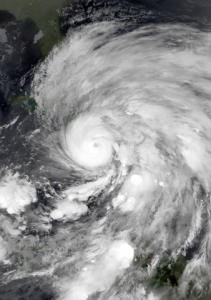![The_Earth_seen_from_Apollo_17[1]](https://alankandel.scienceblog.com/files/2012/11/The_Earth_seen_from_Apollo_171.jpg)
Work to combat continued global greenhouse-gas-emissions rise among industrialized and developing countries leading up to the conference has been encouraging. China, Mexico, the United States and others have pledged to cut carbon and other emissions by varying amounts over different time periods and accomplishing such at different rates. But, ultimately, each is working toward the same goal. And, again, that’s promising.
Worst-case conference scenario and I’d rather not go there, is that a binding climate accord fails to be reached. I’d like to believe talks will truly be constructive; there will be real progress made; realistic, achievable goals will be set; and an overarching spirit of cooperation carries throughout the proceedings in a way that has yet to happen. The reason being is if this is, in fact, the case, then participants of member nations will leave the conference upbeat and in the proper frame of mind to put constructive plans into action. This is important.
Menacing hurricanes

As I write this, a menacing Hurricane Patricia is bearing down on Mexico’s west coast with sustained wind speeds of 200 miles per hour with gusts to as much as 235 mph. I heard on the broadcast news yesterday (Oct. 23, 2015) how this particular storm is the fiercest ever known or recorded. It will only be in the hurricane’s wake that we will know the total damage picture and what the corresponding damage monetarily will be. I am extremely confident that when all is said and done and conditions return to a state of calm, people will be tossing around the notion of this monster of a hurricane’s climate-change connection, much the same way Hurricane’s Katrina in 2005 and Sandy in 2012 likewise did. You can bet this will be a “hot” climate-conference topic.
An easing drought?
For four years so far, the drought, whose impact has been felt all across the western U.S. and that includes the desert southwest, has been seemingly unforgiving, unyielding. Even so, this current dry spell pales in comparison extent-wise to some of history’s so-named “Megadroughts,” some of the likes of which have lasted a half-century according to accounts I’ve read. But this year there may be a breather or easing as a warm-water phenomenon going by the name El Nino has established itself in the northern Pacific and such may have even played a part in Hurricane Patricia forming.
About a week ago, torrential rains rendered portions of both Interstate (highway) 5 and State Route 58 in southern California impassible, due to rivers of sliding mud inundating whole sections of roadway. If the wet weather as a result of warming Pacific Ocean currents does indeed pan out, the west could be in for many repeat occurrences tied, obviously, to the disastrous fires in the west that tore through communities leaving behind devastation in their destructive wakes. Here again, the drought and conflagrations will no doubt be fresh on conference attendees’ minds and in their discussions.
Ever-present pollution
One of the biggest hurdles yet to be overcome is universal acceptance that carbon dioxide is, in fact, an air pollutant. It has officially been declared such. Yet, there are still those who deny this reality.
A couple of things. Firstly, the amount of carbon dioxide in the air has reached unprecedented levels – 400 parts per million of air, give or take. Next, at least one group has proclaimed that in order to prevent a mean global temperature rise of 2 degrees Celsius, CO2 in the atmosphere must not continue its upward ascent. Furthermore, and due to the “added” CO2 in the air, by way of transference, a goodly percentage of that gas is and has been entering major bodies of water like the world’s seas increasing ocean acidity levels which presents a danger to sea life and the ecosystems that support that life. Since the year 1800 the amount of acidity in these waters has risen by 30 percent.
Even if a person is inclined to reject the premise of carbon dioxide as air pollutant, they would do well to understand this: The process by which all the “extra” anthropogenically-caused carbon has entered the air and oceans – attributed mainly to the burning of fossil fuels and at its most fundamental level a highly-polluting process at that – is exactly what is fueling the atmospheric and oceanic carbon rises.
So, even if one chooses to dismiss CO2 as an air pollutant and argues that the gas is needed to support and sustain plant life, which helps support and sustain human and animal life, too much of it can and does have a countervailing, damaging effect; the result of that atmospheric carbon increase being the negative corresponding consequences the world is experiencing today.
The takeaway
In concluding, as I’ve expressed in the past and will emphasize here again, the message that I would like people, readers to take away is this: Air pollution is responsible, according to the World Health Organization, for some 7 million annual premature deaths worldwide. That’s 1-in-8 early deaths resulting from air pollution’s effects. The numbers have worsened. And unless we reverse course regarding the fossil-fuel-burning path chosen, there will be even more such early deaths attributed to the igniting of these fuels.
World leaders have it in their power to make possible a real and measurable difference putting the planet on track to air remedy and recovery and, by extension, ocean remedy and recovery. I urge them to do so.
I remain unwaveringly convinced that if the air-pollution crisis is resolved, we resolve the climate-warming issue in the process. I call that a win-win proposition, don’t you?
This is my take.
Both images above: NASA
This post was last revised on May 20, 2020 @ 6:52 a.m. Pacific Daylight Time.
– Alan Kandel